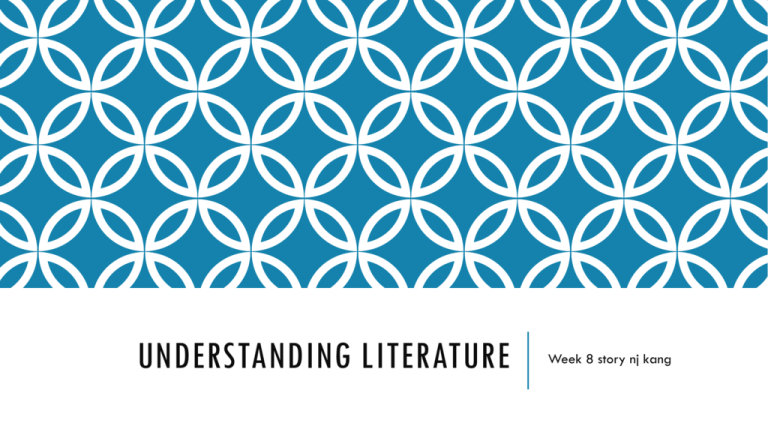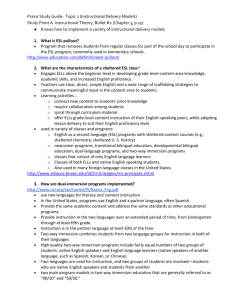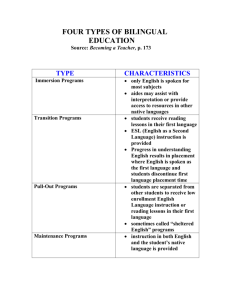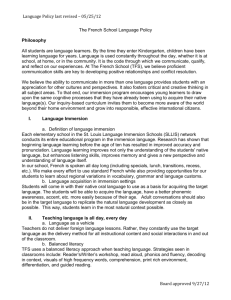File - Nam
advertisement

UNDERSTANDING LITERATURE Week 8 story nj kang APPROACHES TO LITERARY CRITICISM How we are to interpret literature, how we derive meaning from a collection of words on a page. Ways of talking about texts is important It is always difficult to understand other people’s literary experience. FOUR COMMON APPROACHES TO STUDY LITERATURE + TWO OTHER WAYS The reader-response approach The historical approach The psychoanalytical approach The feminist approach The formalist approach The purpose of criticism THE READER-RESPONSE APPROACH (1920 -> 1930) For years, students had been taught that a literary text held a specific meaning and that the study of literature involved the discovery of that meaning. Finding the correct interpretation is the main importance for the reader Nowadays, acknowledge that readers hold widely different interpretations of the same literary work and that the reading process is a highly complex one. Transactional analysis: interpret text through our own pre-experiences Finding an author’s interpretation Finding Diverse individual interpretations RUMPELSTILTZKIN HTTP://RUMPELSTILTSKIN-EV.BLOGSPOT.KR/2010/11/SYNOPSIS_10.HTML Read the story and identify each characters. Rank the order of characters by their ethical attitudes. From the most to least vicious. https://www.youtube.com/watch?v=dfePLGJyV1w Explain your reasons Can you find the best one? THE HISTORICAL APPROACH Questions asked mostly 1. Who is the author and what is his or her object in writing the work? 2. How did the political events of the time influence what the writer wrote 3. How did the predominant social customs of the time influence the writer’s outlook? 4. What is the predominant philosophy that influenced the work? 5. Were there any special circumstances under which the work was written? How the period in which a work was written has influenced the work itself. The external political, social, and intellectual influences on literature. HANSEL AND GRETEL (14C) Historical background Extreme poverty. People eat and sell their own children and hanged people. Use of the oven to cook is the main thing. ROBINSON CRUSOE (1719) Taming the local people in the isolated island and use the nature of it to fulfill his own will was the current philosophy https://www.youtube.com/watch?v=1MN6ynd2srk https://www.youtube.com/watch?v=eu7k0kSvnUo ISLAND OF THE BLUE DOLPHINE (1960) learns to respect the nature and live in harmony https://www.youtube.com/watch?v=N64Tktf4J70 ANY OTHER STORIES? THE PSYCHOANALYTICAL APPROACH It examines a work in relation to its author. Freuidian approach. (Sigmund Freud, 1856 – 1939) The motivations for much of our behavioiur (our fear of heights our compulsion to be neat, our love of a certain color) lay hidden in our unconscious minds. Dreams, art, literature, music etc. HANSEL AND GRETEL BY BETTERLHEIM’S ANALYSIS Oral satisfaction Child’s developmental stage of oral fixation The gingerbread house Oral greediness and how attractive it is to give in to it. Body Effort for returning home By denial (parents abandoned them) Regression (try to go back home), Witch Hansel’s own resistance to move beyond the oral stage. The destructive aspects of orality Threatening mother The suggests that as the children transcend their oral anxiety, and free themselves of relying on oral satisfaction for security, they can also free themselves of the image of the threatening mother –the witch – and rediscover the good parents, whose greater wisdom – the shared jewels- then benefit all (162) PSYCHOANALYTICAL ; ARCHETYPAL ANALYSIS Sees Cinderella story everywhere is that everything heavily depends on symbols and patterns operating on a universal scale. https://www.youtube.com/watch?v=mkOdV7bu1tM Cinerella Christ Little red Ridinghood Light, sun Fox Evel, dark. THE FEMINIST APPROACH How are women portrayed in the work? As stereotypes? As individuals? How is the woman’s point of view considered? Is male superiority implied in the text? In what ways is the work affected because it was written by a woman? Or a man? Major concern To read a text as a woman Female Masculine bias in literature From man’s point of view For male readers Questioning its underlying assumptions about differences between men and women that usually posit women as inferior Beautiful Inferior THE FORMALIST APPROACH A literary text should be regarded as an object to be analyzed for meaning ap0art from the values or beliefs of the author or reader.\ Should disregard everything except the literary elements of a work. Rising and falling dramatic action and on the building of suspense as the children overhear their parents plotting. The chief tension – the conflict– in a text as the source of its unity, and tension. THE ELEMENTS OF LITERATURE Points of view Setting Characters Plot and conflict Theme Style Tone Literature as art. POINTS OF VIEW First- person point of view: if the narrator refers to him-herself as “I” in the story Omniscient (all knowing) point of view: one in which the autor excercises unlimited powers of knowing the thoughts and actions of anyone in the sotry at any time and any place. Limited point of view (subjective consciousness): a story is told from the viewpoint of a single character in the story- but not told by that character SETTING Refers to the time, the geographical place, the general environment and circumstances that prevail in a narrative. CHARACTERS Flat and round characters: stereotype of a stock character Static and Dynamic characters: Foil characters: is one who possesses personality traits opposite to those of another character, often the main character. Character development and consistency TYPES OF CONFLICT 1. The individual against another 2. The individual against society 3. The individual against nature 4. The individual against self WHAT IS CBLT? WHAT IS CBI? Language Interlanguage Subject Content WHEN? FOR WHOM? 1980s All age • Met • Linguistically advanced ones CBLT FAMILY CBLT Content Driven Language Driven A CONTINUUM OF CONTENT AND LANGUAGE INTEGRATION Content-Driven Language-Driven Content is taught in L2. Content is used to learn L2. Content learning is priority. Language learning is priority. Language learning is secondary. Content learning is incidental. Content objectives determined by course g oals or curriculum. Language objectives determined by L2 cou rse goals or curriculum Teachers must select language objectives. Students evaluated on content to be integr ated. Students evaluated on content mastery. Students evaluated on language skills/profi ciency. Total CONTENT immersion DRIVEN Partial immersion Sheltered model School Curriculum Content Content Driven Total immersion , the entire school curriculum is taught initially through the foreign language, with content instruction in the L1 gradually increasing through the grades; Partial immersion , at least half the school day is spent learning school subjects in another language. “...subject matter teachers ...may adapt their instruction to accommodate different levels of language proficiency in their classes... [T]he language teacher acts as a resource for other teachers, and ideally, helps those other teachers to increase the mastery of academic concepts and skills on the part of linguistic minority students” (Crandall and Tucker 1990). Rosen and Sasser (1997) note that “...[i]n sheltered English contentarea teachers use a variety of language teaching strategies to enhance understanding of grade- and age-appropriate subject-area concepts” (p. 35). Sheltered courses Students learn one or two subjects entirely through the foreign language, and do not learn these same subjects in L1. The course subject matter defines the learning objectives. There may be little, if any, explicit language instruction. Subject courses are taught in the L2 using linguistically sensitive teaching strategies in order to make content accessible to learners who have less than native-like proficiency. The goal is for students to master content; students are evaluated in terms of content learning, and language learning is secondary. ABOUT LANGUAGE TEACHING Aim to produce students with oral and written proficiency in a foreign language, There may not, be a foreign language curriculum, with defined learning objectives or specific content (functions, vocabulary, grammar, discourse or social competencies, etc.). Rather, the language that students acquire emerges from content instruction and from the day-to-day interactions between teacher and students, or among students themselves. SO Immersion programs, whether partial or total, are often judged successful based on student attainment of content, and may be deemed effective even though the levels of language proficiency students attain are not native-like (Swain and Johnson, 1997; Genesee, 1994). SO IMMERSION Subjects contents L2 Content attainment SO SHELTERED PROGRAMS Subjects contents Content>language attainment L2 LANGUAGE Adjunct DRIVENModel Theme Based Programmes Language Focused Programmes SO LANGUAGE DRIVEN Language Language attainment content THE ADJUNCT MODEL Both language and content are the goal. Lies at the center of the continuum of content/language integration. Students are expected to learn content material while simultaneously acquiring academic l anguage proficiency. Content instructors and language instructors share responsibility for student learning, with st udents evaluated by content instructors for subject matter mastery, and by language instruct ors for ‘language skills. Unlike sheltered courses, where students are all learning content in an L2, in the adjunct mo del content classes may be comprised of both L1 and L2 content learners, but language inst ruction is almost always for L2 learners. SO THE ADJUNCT MODEL Language Language and content attainment Content THE THEME BASED MODEL Is language-driven: the goal of these courses is to help students develop L2 skills and proficiency. Themes are selected based on their potential to contribute to the learner’s language growth in specific topical or functional domains. Unlike sheltered courses, which are taught by content instructors, and adjunct courses that are co-taught, theme-based courses are taught by language instructors to L2 Learners who are evaluated in terms of their language growth. Students (and their teachers) are not necessarily accountable for content mastery. Indeed, content learning is incidental. SO THE THEME BASED MODEL Singing songs Language objectives Roleplaying Surveys Theme or topic Assessment Drawing Language Attainment CONTENT AND LANGUAGE CONTINUUM Content Driven Total Immersion Partial Immersion Sheltered Model Language driven Adjunct Model Theme based courses Language focused with some contents THEN, WHAT SHALL WE USE? Total Immersion? Partial Immersion? Sheltered Programmes? Adjunct Programmes? Theme Based Programmes? Language Focused Programmes? HOW’S CONTENT DRIVEN PROGRAMMES? Total Immersion? Partial Immersion? Sheltered Programmes? For High level in L2? Fossilized expression? Too difficult for Teachers? HOW ABOUT LANGUAGE DRIVEN? Too boring?? Misunderstan ding cognitively appropriate theme?? Lose interest? Theme Based Programmes? Language Focused Programmes? Adjunct Model? Yeah! But need specific language and content input. Language Focused Programmes? Because! Cognitive Development EFL Content Kindergarten 6th Grade LEARNERS’ PERCEPTIONS CONCERNING ENGLISH LASSES very interesti ng interesti ng boring very boring No respo nse 3 59 51% 42 37% 8 7% 2 2% 4 3% 0 115 100 % 4 51 50% 25 25% 22 22% 1 1% 2 2% 0 101 100 % 5 27 23.5 % 50 43.5 % 26 23% 8 7% 4 3% 0 115 100 % 6 19 10% 62 34% 84 45% 17 9% 2 1% 2 186 100 % so so 1 % Total LEARNERS’ PICTURE OF THEIR PARTICIPATION RATE IN THE ENGLISH CLASSES Always Some times Rarely No response Total 3rd 70 61% 38 33% 4 3% 4 3% 115 100 % 4th 63 62% 33 33% 3 3% 2 2% 101 100 % 5th 73 63.5 % 36 31% 2 2% 4 3.5% 115 100 % 6th 81 44% 86 46% 11 6% 8 4% 186 100 % SURVEY Subjects: 517 learners of Korean public primary schools in Kyungi province. Questions: What are the learners’ perceptions about their English classes? What are the learners’ impressions about their participation in English classes? What view do the learners have about their participation in other subject classes LEARNERS’ PARTICIPATION RATE IN OTHER SUBJECTS Grade 3 Grade 4 Grade 5 Grade 6 Always 49 43% 35 35% 87 76% 107 58% Some times 57 50% 63 62% 25 22% 75 40% Rarely 6 5% 1 1% 3 2% 4 2% No response 3 3% 2 2% 0 0% 0 0% Students’ cognitive level English text content ENGLISH TOPICS FOR RD 3 GRADE (1997) Topics Units Language Weather Unit 16 Sunny, Cloudy, Snowy, Rainy, Cold, Hot, Food; Unit 11, 15 Hamburgers, Sandwich, Orange juice, Ice-cream. Clothes Unit 12 Shirt, Skirt, Cap, Dress Animal Unit 14 Cow, Dog, Pig, Cat Sports Unit 13 Soccer, Baseball, Basketball, Badminton Family Unit 10 Father, Mother, Sister, Brother Personal objects Unit 3, 4, 6 Cap, Pencil, Glove, Ball, Book bag, Book House Unit 5 and 9 My room, Bathroom, Kitchen, Living Room Others Unit 1, 2, 7, 8 These units can not be included in any categories TOPICS FOR RD 3 Title 1 One by one 3 The clean country 4 Researching Attitudes GRADE ‘READING’ Topics 1) A life story of a salmon 2) A pond skater, the swimmer Category Informative ScienceFiction Learning Focus Summarize the story into a beginning, middle and ending Environment 1) The Sol River 2) Keeping water clean studies 3) Kyu-Hee’s Story. 4) Yun-soo’s Story 5) Gun-ho’s Story - A fiction about a polluting driver - Children’s personal opinion about keeping the water clean - What is your opinion? 1) Life of Pabre the insect researcher 2) Suk,Joo-Myung, the butterfly researcher - summarize the lives of these researchers - What is the reason for them to study insects? - What did they do to carry out their research? - What do you think about them? Biographical stories Cognitive Development EFL Content Kindergarten 6th Grade TOPICS IN ENGLISH TEXTBOOK (2007) Topics 3rd 4th 5th Language Numbers 6 3, 4 8 6 1 ~ 10, 1~20. How old are you? What time is it? How much is it? 1~ 30 Food 5 Clothes Weather 8 8 Animal 6 Sports 7 7 8, 11 Swim, skating, skiing, jumping, running, dancing, tennis, football, baseball, kicking Personal objects Body parts 2,3 6 9 4 2 7 Cap, Pencil, Book bag, Book, Tooth, eyes, mouth, hands, nose, wash, Don’t do ~ Apples, chicken, meat, grapes, ice-cream, bananas 1 15 Shirt, sweater, jumper, boots, pants, mitten Snowing, raining, sunny, cold, hot, warm Cows, monkeys, bears, dogs, pigs, cats, kangaroos, TOPICS IN SOCIAL STUDIES AND PRACTICAL STUDIES FOR 6TH GRADE Subject Topic (content) Social study • Pre-history –United Silla, Balhae, Unified Korea and its politics, culture. Chosun Dynasty and its politics, culture, wars. The latter period of Chosun and its culture. Development of its agriculture and commercial industry, The religions, The invasion of foreign countries, The period of the Korean empire • Modern Society : Independent Korea from Japan, The foundation of Korean and its development Practical Studies • Variety kinds of jobs in the world – Understanding different functions and roles of jobs. Planning personal future jobs through analyzing individual characteristics, aptitude. • Environmental studies • Cooking • Learning to use and making things using a sewing machine • Making things with wood • Raising a pet • Working with the computer Other Subjects Geography Environment Future jobs Friendship History Empires War Cooking Industries Culture Computers Etc… English Classes Colors My family Zoo animals Likes REGULAR CLASSES ENGLISH CLASSES HOMEWORK Choose one story and analyse the story using all four approaches of critics. Read chapter 11 & 17 & 23 Focused questions will be given to you through email. FOCUSED QUESTIONS 1. When do babies first become aware of themselves and how do people know they know it? How we can use of it in our ELT? 2. By what age do babies understand other people have different intentions toward people and objects? How do people understand the babies of a certain age understand it? And how can we use of it in ELT? 3. Is it possible to teach or ask what do 24 months old babies about what they want to eat and do in a certain context? How can we use it in ELT? 4. What is the intention of ‘schematic representation of the location change task developed by Wimmer & Perner(1983)? How can we use it in ELT? 5. Do children truly believe in magic, or do they recognize that such beliefs belong to the realm of fantasy? Please answer this question using some experiments described in the chapter. 6. Explain three types of book discussion questions and apply these questions using one story book for children of age 7. 7. What is reader-response essays and how would you ask your learners to do it if they are 3rd grade novice ELL? 8. What kind of stories reflect the psychological and social realism? Please explain these two realism respectively and find two books that reflect each realism.







